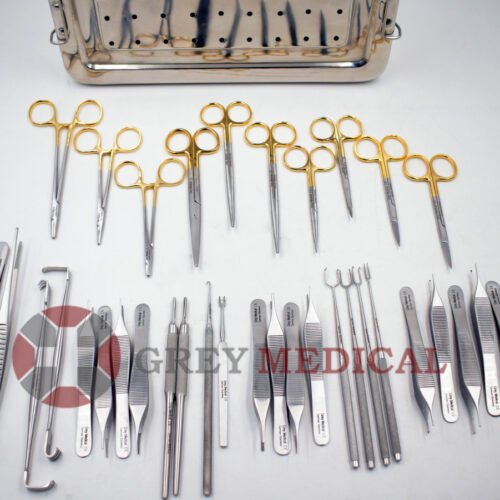In the realm of plastic surgery, precision and quality are paramount. The success of procedures, whether cosmetic or reconstructive, heavily relies on the surgical instruments employed. This blog will explore the top ten essential instruments commonly found in plastic surgery sets, discussing their functions, features, and importance in achieving optimal surgical outcomes.
1. Scalpel
Function: A scalpel is a small knife used for incisions in surgery.
Features: Available in various blade sizes and shapes, scalpels are designed for precision cutting. Disposable blades can be easily replaced to maintain sterility.
Importance: The scalpel is fundamental for making incisions in the skin and underlying tissues, setting the stage for the entire surgical procedure.
2. Scissors
Function: Surgical scissors are used for cutting tissues and sutures.
Features: They come in various designs, such as curved, straight, and blunt-tipped. Some scissors are specifically designed for delicate tissue, like those used in facial surgeries.
Importance: Scissors allow surgeons to perform intricate cuts with precision, minimizing damage to surrounding tissues.
3. Forceps
Function: Forceps are used to grasp, hold, and manipulate tissues during surgery.
Features: There are several types of forceps, including tissue forceps with teeth for a secure grip and non-toothed forceps for delicate tissues.
Importance: Forceps provide the surgeon with control and stability when working with tissues, ensuring precise movements during surgery.
4. Needle Holder
Function: A needle holder is designed to securely hold needles while suturing.
Features: Most needle holders have ratchet mechanisms to lock the needle in place, allowing for precise suturing.
Importance: Proper suturing is critical in plastic surgery to ensure optimal healing and minimal scarring. The needle holder allows for controlled, accurate suturing.
5. Retractors
Function: Retractors are used to hold back tissues and provide better visibility and access to the surgical area.
Features: They come in various shapes and sizes, including handheld and self-retaining types, allowing for versatile use in different procedures.
Importance: By holding back tissues, retractors enable the surgeon to work more efficiently and with greater accuracy, reducing the risk of injury to surrounding structures.
6. Electrocautery Device
Function: This device is used for cutting and coagulating tissue using high-frequency electrical currents.
Features: Electrocautery devices can be handheld or connected to more extensive surgical systems, providing precise control over tissue damage and bleeding.
Importance: By minimizing blood loss and improving visibility during surgery, electrocautery devices enhance overall surgical efficiency.
7. Suction Device
Function: Suction devices are used to remove blood, fluid, and debris from the surgical site.
Features: These devices come in various sizes, often with specialized tips to reach confined areas.
Importance: Maintaining a clear surgical field is essential for safety and precision, and suction devices play a crucial role in achieving this.
8. Hemostatic Forceps
Function: Hemostatic forceps are designed to control bleeding by clamping blood vessels.
Features: These forceps often feature a ratchet mechanism for secure gripping, with serrated jaws to provide additional traction.
Importance: Controlling bleeding is critical in plastic surgery, and hemostatic forceps help ensure patient safety throughout the procedure.
9. Graft Instruments
Function: Instruments specifically designed for harvesting and placing skin grafts.
Features: These may include dermatome blades for cutting grafts and specialized forceps for handling delicate graft tissue.
Importance: Skin grafting is a common technique in plastic surgery, and having the right instruments ensures the best possible outcomes for graft acceptance and healing.
10. Surgical Drapes and Covers
Function: While not instruments in the traditional sense, drapes and covers are crucial for maintaining a sterile environment during surgery.
Features: These materials come in various sizes and are designed to cover the patient and surgical area, preventing contamination.
Importance: Ensuring a sterile field is fundamental in any surgical procedure to reduce the risk of infection and promote healing.
Conclusion
The instruments in plastic surgery sets are carefully selected to enhance surgical precision and patient safety. Each instrument plays a specific role in ensuring that procedures are performed effectively and with minimal complications. By understanding the essential tools used in plastic surgery, healthcare professionals can make informed decisions about their instrument selection and care, ultimately improving patient outcomes.





Comments